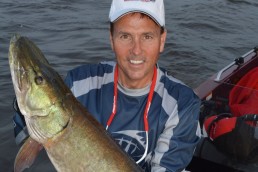Long Spawning Season for Reelfoot’s Big Bream
SHARE THIS POST
Although the full moon back in May marked the beginning of the bluegill spawn, the fish are reportedly continuing their season into the summer on Tennessee’s Reelfoot Lake, which is renowned for its bluegill fishery. That’s where my fishing buddy Doug Markham, of Nashville, Tenn., and I learned new techniques with guide Patrick Johnson.
When Doug and I arrived to fish, a wind was howling out ahead of a storm located to the south at better than 25 mph. We were betting the fishing trip would be called off. Not so, because we headed into the trees at the northeast end of the lake where the wind was only a whisper in the distance.
Patrick maneuvered the boat among the numerous stumps and trees while we dropped our jigs next to the trunks. “Rosebushes growing from cypress trees and stumps are the best places to catch the bigger bluegills on Reelfoot,” said Patrick, who grew up fishing the lake.
Bluegill gear
He replaced the traditional bream hook with a tiny jig and baited it with a waxworm. A couple of small split shots were added above the jig followed by a float to fish about 3 feet deep.
Patrick and Doug used 10-foot graphite poles with fly rod reels holding 12-pound-test line. I used my crappie outfit: a 12-foot pole with a small spinning reel and 8-pound-test line. That extra 2 feet made it difficult to wield the rod among the trees and the lighter test line did not allow any ripping of my terminal tackle from the limbs. The spinning reel kept messing up by getting line behind the spool. The lesson was that I should have used the guide’s equipment; it is designed especially for Reelfoot’s fishing conditions.
In spite of my minor malfunctions, we caught ’em—about 100! I lucked up and caught the biggest bluegill of my life. It weighed more than a pound, and as large as two hands put together. Any fish less than the width of your hand was tossed back. Not every tree or stump had a ‘gill on it, but where we caught one, we usually caught two or three more.
Summer spawns
Bluegills tend to use the same nest year after year, which makes it easier for anglers to keep track of the best fishing holes. The popular opinion among dedicated ‘gill anglers is that the female visits the nest on the full moon after the water has reached the upper 60s or lower 70s and returns each month to spawn again—until it’s time to quit for the fall.
Are you enjoying this post?
You can be among the first to get the latest info on where to go, what to use and how to use it!
Patrick said one sure way to locate ‘gills is to look for bubbles in an area the size of a bathtub. Explanations range from the bubbles coming from the bluegills’ mouths while preparing the bed to whipping bubbles from the bottom while cleaning the bed. Many biologists haven’t studied this, but it may not be from their mouths because their air bladders do not connect with it. The best guess is that air trapped in the bottom is released in the process of bed cleaning.
After the spawn is over, many bream anglers swap their poles for bass-casting gear. That’s not necessary; ‘gills spawn all summer long around the full moon periods. Three or four days before the full moon, bull bream move in to prepare the bed and the females come in to spawn on the full moon. Fewer bluegills spawn during the summer than in the spring, but you can find enough to get a thrill and a skillet full.
Topwater ‘gills
It’s so much fun catching bluegills on topwater. My favorite way to catch them in summer is with a tiny Rebel Minnow cast on ultralight gear with 4-pound-test line. Cast it, let the ripples fade and then twitch it. The landing of the lure attracts the fish, the bream study the lure and then the twitch triggers the strike. The best part is that the lure only catches keeper-sized bluegills. The ones you would cull can’t get the treble hook in its mouth.
Popping bugs are my next choice. A 4-weight fly outfit adds sport to playing chunky bream. Black ants, poppers and spiders tease the ‘gill into hitting. Use the same cast, pause and twitch technique. If you’re not fishing Reelfoot’s abundant natural cover, almost any man-made structure will hold bluegills. Docks, boat ramps and bridges come to mind, but look around for other similar structures, especially if your lake doesn’t have downed trees and stumps.
Summertime is ‘gill time, and children love to catch them too. Help some youngsters pull in a few and you can help make lifelong memories they won’t forget.
Recently, Vernon Summerlin has begun publishing Kindle eBooks on Amazon. He plans to publish a short fishing book once a week. Larger books and other topics of his are in the works. You can search amazon.com and type in “Vernon Summerlin.” Please send any thoughts, requests, etc. to vsummerlin@comcast.net.
MWO
SHARE THIS POST
Did you enjoy this post?
You can be among the first to get the latest info on where to go, what to use and how to use it!
Vernon Summerlin
For more than 30 years, Vernon Summerlin has produced outdoor articles and books that can be found on Amazon; most recently How to Analyze a Bass Hole: Think and Catch’em! He is the recipient of more than 40 awards for magazine and newspaper articles, TV, radio, photography and books.



